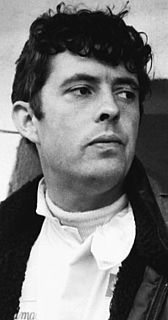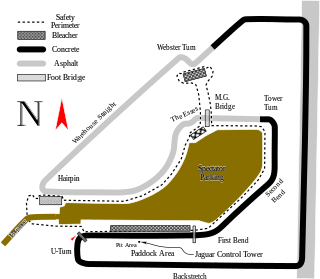
Olivier Jean Marie Fernand Gendebien was a Belgian racing driver who was called "one of the greatest sportscar racers of all time".

Masten Gregory was an American racing driver. He raced in Formula One between 1957 and 1965, participating in 43 World Championship races, and numerous non-Championship races. He was also a successful sports car racer, winning the 1965 24 Hours of Le Mans.

Brian Herman Thomas Redman, is a retired British racing driver.
Fred K. Gamble is an American racecar driver. He participated in one Formula One Grand Prix, the 1960 Italian Grand Prix, on September 4, 1960. He finished 10th overall driving the Formula Two Behra-Porsche, scoring no Championship points.

Mark Neary Donohue Jr., nicknamed "Captain Nice," and later "Dark Monohue," was an American race car driver and engineer known for his ability to set up his own race car as well as driving it to victories.

Peter Nield Whitehead was a British racing driver. He was born in Menston, Yorkshire and was killed in an accident at Lasalle, France, during the Tour de France endurance race. A cultured, knowledgeable and well-travelled racer, he was excellent in sports cars. He won the 1938 Australian Grand Prix, which along with a 24 Heures du Mans win in 1951, probably was his finest achievement, but he also won two 12 Heures internationales de Reims events. He was a regular entrant, mostly for Peter Walker and Graham Whitehead, his half-brother. His death in 1958 ended a career that started in 1935 – however, he was lucky to survive an air crash in 1948.
Walter Edwin Hansgen was an American racecar driver. His motorsport career began as a road racing driver, he made his Grand Prix debut at 41 and he died aged 46, several days after crashing during testing for the 1966 24 Hours of Le Mans.
John Cooper Fitch was an American racing driver and inventor. He was the first American to race automobiles successfully in Europe in the post-war era.

Lake Underwood was an American entrepreneur who competed as a champion in the racing of prototype automobiles and motorcycles. He was a master mechanic who, although high performance fuel delivery and carburetor design and mechanics were his specialties, also invented automobile improvements, especially in electronics for German automobiles.
John Lee Paul Jr. was an American racing driver. He competed in CART and the Indy Racing League competitions, but primarily in IMSA GT Championship, winning the title in 1982.

The 1955 24 Hours of Le Mans was the 23rd 24 Hours of Le Mans and took place on 11 and 12 June 1955 on Circuit de la Sarthe. It was also the fourth round of the F.I.A. World Sports Car Championship. During the race, Pierre Levegh crashed into a crowd of spectators, killing 84 and injuring 120 in the deadliest accident in motor racing history.

The 1955 Florida International Twelve Hour Grand Prix of Endurance took place on 13 March, on the Sebring International Raceway. It was the second round of the F.I.A. World Sports Car Championship. For the fifth running of the event, the 5.2 mile course had been widened and smoothed with a new asphalt topping laid down. This was for safety and would allow the cars to achieve greater speed, especially in some of the corners.
Philip F. Walters was an American racing driver, who won both the 12 Hours of Sebring and Watkins Glen Grand Prix twice.

The 1956 Florida International Grand Prix of Endurance powered by Amoco took place on 24 March, on the Sebring International Raceway,. It was the second round of the F.I.A. World Sports Car Championship. For the sixth running of the event, was a sign to many in the automotive community that this race had become North America's premier sports car race, and from an international standpoint second only to the 24 Hours of Le Mans.
Robert John Wilder, Jr., was a native of Massachusetts, who was an American racing driver who competed in the SCCA National Sports Car Championships between 1951 and 1953.

The 1958 12-Hour Florida International Grand Prix of Endurance for the Amoco Trophy took place on 22 March, on the Sebring International Raceway,. It was the second round of the F.I.A. World Sports Car Championship, which was running to new regulations introduced at the beginning of the season. The most influential of these regulations changes would be the 3.0 litre engine size limit. This was seventh running of the 12-hour race.

The 1959 12-Hour Florida International Grand Prix of Endurance for the Amoco Trophy was a motor race for sportscars, staged on 21 March at the Sebring International Raceway, Florida, United States. It was the opening round of the 1959 World Sportscar Championship and was the eighth running of the 12 Hours of Sebring.
Bill Rutan was a racing driver and hillclimb racer. Rutan was the winner of the Climb to the Clouds hillclimb in 1961. Rutan also won the SCCA National Championship Runoffs twice in the Formula C class.
Briggs Swift Cunningham II was an American entrepreneur and sportsman. He is best known for skippering the yacht Columbia to victory in the 1958 America's Cup race, and for his efforts as a driver, team owner, and constructor in sports car racing, including the 24 Hours of Le Mans.
The Cunningham C-6R was a sports car developed in 1954 for the Briggs Cunningham racing team.







